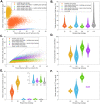Assessing the impact of lateral flow testing strategies on within-school SARS-CoV-2 transmission and absences: A modelling study
- PMID: 35622860
- PMCID: PMC9182264
- DOI: 10.1371/journal.pcbi.1010158
Assessing the impact of lateral flow testing strategies on within-school SARS-CoV-2 transmission and absences: A modelling study
Abstract
Rapid testing strategies that replace the isolation of close contacts through the use of lateral flow device tests (LFTs) have been suggested as a way of controlling SARS-CoV-2 transmission within schools that maintain low levels of pupil absences. We developed an individual-based model of a secondary school formed of exclusive year group bubbles (five year groups, with 200 pupils per year) to assess the likely impact of strategies using LFTs in secondary schools over the course of a seven-week half-term on transmission, absences, and testing volume, compared to a policy of isolating year group bubbles upon a pupil returning a positive polymerase chain reaction (PCR) test. We also considered the sensitivity of results to levels of participation in rapid testing and underlying model assumptions. While repeated testing of year group bubbles following case detection is less effective at reducing infections than a policy of isolating year group bubbles, strategies involving twice weekly mass testing can reduce infections to lower levels than would occur under year group isolation. By combining regular testing with serial contact testing or isolation, infection levels can be reduced further still. At high levels of pupil participation in lateral flow testing, strategies replacing the isolation of year group bubbles with testing substantially reduce absences, but require a high volume of testing. Our results highlight the conflict between the goals of minimising within-school transmission, minimising absences and minimising testing burden. While rapid testing strategies can reduce school transmission and absences, they may lead to a large number of daily tests.
Conflict of interest statement
The authors have declared that no competing interests exist.
Figures



References
-
- Office for National Statistics. Coronavirus and the social impacts on Great Britain: 29 January 2021; 2021. Available from: https://www.ons.gov.uk/peoplepopulationandcommunity/healthandsocialcare/....
-
- House of Commons Library. Briefing Paper Number 8866, 18 January 2021—Coronavirus: Economic impact; 2021. Available from: https://researchbriefings.files.parliament.uk/documents/CBP-8866/CBP-886....
-
- DELVE. Balancing the Risks of Pupils Returning to Schools; 2021. Available from: https://rs-delve.github.io/reports/2020/07/24/balancing-the-risk-of-pupi....
-
- Centre for Education Policy and Equalising Opportunities. Briefing Note: School Absences and Pupil Achievement; 2021. Available from: https://repec-cepeo.ucl.ac.uk/cepeob/cepeobn1.pdf.
Publication types
MeSH terms
Grants and funding
LinkOut - more resources
Full Text Sources
Medical
Miscellaneous

